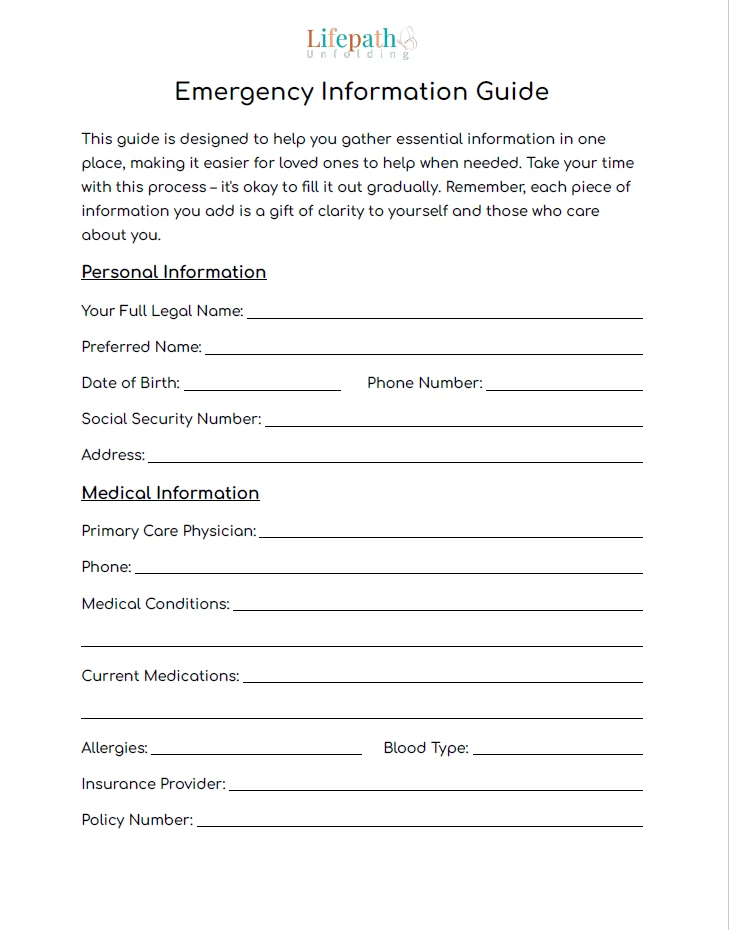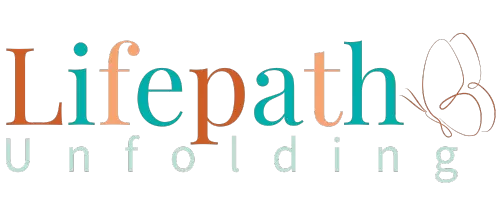First Steps: Creating Your Life Security Plan
A Self-Care Guide for Women
It starts with a quiet, perhaps unsettling thought: “What happens if I’m not here to handle it all?” That moment, though unnerving, is pivotal—it’s the gentle nudge reminding us of what we truly value. A life security plan isn’t just about paperwork or preparing for the unexpected; it’s about self-respect, caring for those we love, and allowing ourselves the peace to focus on the things that matter most. By taking small, manageable steps today, you’re creating more than just a plan—you’re fostering a sense of control and confidence in your own path forward.
The Reality Check
Starting your life security plan might feel like you’re opening a box of tangled cords—overwhelming, confusing, and tempting to set aside for later. If the thought of sorting through legal terms, financial paperwork, or emergency contacts makes your heart race, you’re not alone. It’s a heavy emotional lift, one that comes with questioning your own preparedness and the vulnerability of facing life’s uncertainties. But what if you reframed it as an act of self-compassion rather than a task filled with dread?
The truth is, many of us hesitate to start because it feels like planning for the unthinkable. Letting these fears linger can leave you unprepared and anxious. But it’s important to recognize this process for what it truly is: a way of honoring yourself and your loved ones. Instead of seeing it as bracing for the worst, think of it as putting down roots while granting yourself the freedom to grow in other parts of your life. Groundwork today becomes peace of mind tomorrow.
Common Emotional Barriers to Planning

Facing the concept of mortality, illness, or emergencies doesn’t just bring logistical challenges—it brings emotional ones too. For many of us, the process can stir feelings of anxiety or loneliness, particularly if we’re tackling it solo. It’s easy to think, “What if I do this wrong?” or “Why does this fall entirely on me?” These concerns can freeze even the most resilient among us from taking those first steps.
Rather than letting the fear define you, acknowledge it. Remind yourself that creating a life security plan is not about anticipating doom—it’s about securing your freedom. The act of planning becomes a way of putting your mind at rest, so you can focus on living fully and engaging with your passions.
The Power Shift: From Reactive to Proactive
When you ignore these preparations, life can feel like you’re waiting for the other shoe to drop. By stepping into this process intentionally, you shift from reacting to life’s surprises to creating a sense of control. Think of it like adding bumpers to a bowling lane—while you can’t control every roll of the ball, you ensure it stays in play and on course.
This isn’t just about you. It’s also about removing unnecessary stress for those who care for or depend on you. Knowing you’ve put the pieces in place so that your loved ones won’t feel lost or overwhelmed creates a ripple effect of calm and clarity.
Planning as an Act of Self-Care

Creating your life security plan isn’t just another task to check off; it’s an intentional form of care for yourself and others. Think about it like planting a garden. At first, it feels like an uphill effort—digging, dealing with dirt, and figuring out which plants go where. But over time, those seeds bloom into something you’ll be proud of, giving you joy and tranquility along the way.
With clear steps and a focused mindset, the process can actually become empowering. Begin with smaller, manageable tasks—organizing key documents, setting emergency contacts, or writing down a few wishes for your care. These aren’t just chores; they’re acts of grace toward your future self.
Taking on this responsibility today is an investment in both your emotional freedom and your ability to embrace life’s opportunities well-prepared. Each small step forward will feel less like a burden and more like a personal victory.

Starting Where You Are
Creating your life security plan doesn’t begin with perfection; it starts with acknowledging where you are today. This step isn’t about having everything figured out; it’s about taking a moment to pause, assess, and begin. Imagine standing at the trailhead of a hike. You might not have packed everything perfectly, but the important thing is that you’ve laced up your boots and stepped onto the path. So, where do you start? Right where you are.
Simple Assessment of Current Documentation

The first step is to look at what you already have. You likely have pieces of your life security plan scattered across your home, some in file folders, others in email attachments, or perhaps still in your head. Take a moment to jot down what comes to mind without worrying about gaps or details. This list may include things like:
- Bank account information
- A will or estate plan (if it exists)
- Medical records
- Insurance policies
- Emergency contact lists
Think of this step as shining a flashlight into your cluttered attic—the goal isn’t to organize everything right now, it’s simply to know what’s there.
Reflecting on What Feels Uncertain
Once you’ve taken stock, ask yourself a simple but profound question: “What aspects of my future feel most uncertain?” This is an opportunity to identify areas that might weigh on your mind. For some, it could be financial stability; for others, it might be health-related fears or concerns about how loved ones will manage without them.
Write these down, too. This exercise isn’t meant to overwhelm—it’s like making a grocery list for peace of mind. You’re clarifying what’s needed to move forward.
Start a “Life Security Plan” Folder

After you’ve noted what you have and what’s missing, create a dedicated physical or digital folder labeled “Life Security Plan.” You don’t need to organize everything in one sitting. For now, this folder becomes your home base—a space to collect documents as you find them and a reminder that you’ve begun the journey.
If you feel unsure of what to include, begin with the essentials: a copy of your ID, a list of medications you take, or your emergency contacts. Keep it simple—each addition is progress.
One Document Can Make the Difference
Remember, starting doesn’t have to be monumental. A friend began her journey with a single document: an index card taped to her fridge listing her emergency contacts. That small, proactive step not only brought her a sense of relief but also inspired her to gradually assemble a comprehensive plan. It’s proof that even the smallest start can build momentum.
Each of these steps helps you establish a foundation that’s manageable, meaningful, and deeply connected to your values. Remember, starting where you are is not just okay—it’s enough.
“Creating a life security plan isn’t about preparing for the worst ~ it’s about creating space for your best life to unfold.”
Gathering Your Circle

Building a life security plan isn’t just about documents and to-do lists; it’s also about people — the trusted individuals who will stand by your side when life takes an unexpected turn. Think of this as assembling your personal circle of advisors — a group that provides both practical and emotional support. This step not only ensures your plans are executable but also reinforces the feeling that you’re not navigating this journey alone.
Identifying Key Support People
Who do you trust to handle critical tasks or make decisions on your behalf if needed? This could include family members, close friends, or even professionals. Think carefully: Who has shown reliability and genuine care in your life? Avoid defaulting to the nearest or loudest voice; instead, focus on those who truly know you and respect your wishes.
Start with these reflective questions:
- Who is dependable in times of need?
- Who shares my values and communicates well with me?
- Who has the ability to provide calm, informed guidance under pressure?
This might result in a mix of individuals, from a sibling who knows your long-term wishes to a friend who can handle logistics without breaking a sweat. Remember, this is your circle — customize it to fit your unique life and needs.
Three Roles to Consider

Everyone in your life brings different strengths, and it can help to assign specific roles rather than asking one person to handle everything. Here are three key roles to consider as you refine your circle:
- The Keyholder: This person is entrusted with access to your life security folder and documents. They should be someone who understands the importance of privacy and confidentiality.
- The Decision-Maker: This person might act as your medical decision-maker or financial power of attorney, stepping in for decisions only when necessary.
- The Emotional Anchor: This is someone who will offer support to your loved ones or help coordinate logistics in emotionally heavy moments.
By assigning roles, you’re reducing overwhelm for both yourself and your support network, ensuring no single person bears the full load.
Starting the Conversation
Once you’ve identified potential members of your circle, it’s time to bring them into the fold. This can feel daunting — after all, these aren’t everyday conversations. But approaching the topic with honesty and clarity sets the tone for a productive discussion.
Try framing your conversation with these elements:
- Transparency: “I’m working on organizing important details in case of an emergency, and I’d like you to be part of my support system.”
- Simplicity: “Here’s what I need help with,” followed by specifics — like holding access to documents or supporting loved ones.
- Gratitude: “It means so much to me that I can count on you for this.”
These conversations are less about assigning “jobs” and more about creating mutual understanding. Many people feel honored to be included in a plan of this nature, recognizing the deep sense of trust it represents.
Asking for Help Isn’t Weakness
It’s easy to feel like reaching out is a sign of dependency, but asking for help is an act of strength. It’s about allowing the people who care about you to show up in ways that matter, creating bonds that grow even stronger over time. Instead of thinking, “I should handle this alone,” imagine what you’d hope to do for a friend in the same situation — you’d probably show up willingly, without hesitation. Let your circle of support extend that same gift to you.
Creating your circle isn’t about preparing for disaster; it’s about embracing connection and community. Each trusted person becomes a thread in the fabric of your plan, strengthening the foundation you’re building not just for emergencies, but for peace of mind today.

Your First Priority Document

When building a life security plan, the first step often feels the hardest. It’s natural to wonder, “Where should I even begin?” Start with the document that could make the biggest difference in an emergency: your Emergency Information Sheet. This single piece of paper can be a lifesaver, guiding your loved ones or responders in moments when clarity is most needed. It’s about setting the stage for order amidst chaos—an anchor during uncertain times.
What Is an Emergency Information Sheet?
Think of an Emergency Information Sheet as the “cheat sheet” for your life’s essentials in case you’re unavailable to explain them yourself. This document holds concise, critical details about you, such as:
- Contact information for key people (family, close friends, or a trusted neighbor)
- Your medications and medical history
- Insurance policy numbers
- Emergency procedures specific to your home or lifestyle
Imagine someone stepping into your shoes during an emergency. What would they need immediately? If it’s not listed on this page, they might be left guessing. Emergencies rarely come with warning, and this document ensures you’re prepared.

Download Your 4-Page
“Emergency Information Guide”
How to Get Started
Begin by reflecting on a crucial, yet straightforward question: “What would someone need to know if I couldn’t tell them?” This can guide what to include and make the process feel less overwhelming. Don’t try to perfect everything at once — this is about progress, not perfection. Here’s a starting point:
- Write down your full name, address, and primary emergency contact.
- Add your primary care physician and key specialists, including phone numbers.
- List any medications you take regularly, including dosages.
- Jot down key details about allergies or conditions like diabetes, hypertension, or asthma.
These foundational elements lay the groundwork for a robust emergency sheet.

Moving Forward

Taking the next steps in creating your life security plan is about building momentum, not racing to the finish line. This phase invites you to layer intentionality into your efforts, recognizing that progress grows from consistent, purposeful action. Think of it as weaving a safety net—each knot tied strengthens the whole, offering greater peace and stability along the way.
Three Actions You Can Take This Week
If you’re unsure how to proceed, start small. Work on bite-sized tasks that fit comfortably into your schedule. These micro-actions may seem simple but allow for steady, meaningful progress.
- Choose One Document: Identify a high-priority document that feels manageable to tackle. This could be listing your medical contacts, writing down medication details, or preparing an emergency contact card.
- Dedicate 30 Minutes for Organization: Block out half an hour this week to review files, gather loose paperwork, or organize a digital folder. Use this time to tidy and identify gaps without pressure to perfect everything.
- Have One Key Conversation: Speak to someone who might play a role in your plan. Whether you’re asking for their support or clarifying shared information, open the dialogue—it helps ease potential discomfort over time.
These actions help you break inertia. A simple conversation or 30 minutes of organizing can be transformative, creating clarity and motivation for what lies ahead.
Every Small Step Counts

It’s easy to minimize the value of small wins, but those little steps have a cumulative effect. Think about planting seeds in a garden—one by one, they don’t seem like much. But with time, care, and patience, they grow into something remarkable. Your commitment to taking small, consistent actions will yield the foundation of a life security plan that truly reflects your values and needs.
Celebrate progress, even if it’s as simple as labeling a digital folder or finishing one phone call. These steps build a roadmap toward ease and readiness, not just for crises but for living with more focus on what matters most to you.
This journey isn’t about perfection or completing everything at once—it’s about gradually building something meaningful that reflects your values and priorities. Each item you include, each contact you list, each folder you organize, is a declaration that your life and peace deserve to be prioritized.
So, what one small step will you take this week to begin your plan? Maybe it’s creating an emergency contact list or starting that “Life Security Plan” folder. Whatever it is, remember: starting is already a success, and every step forward brings more ease and confidence into your life.

